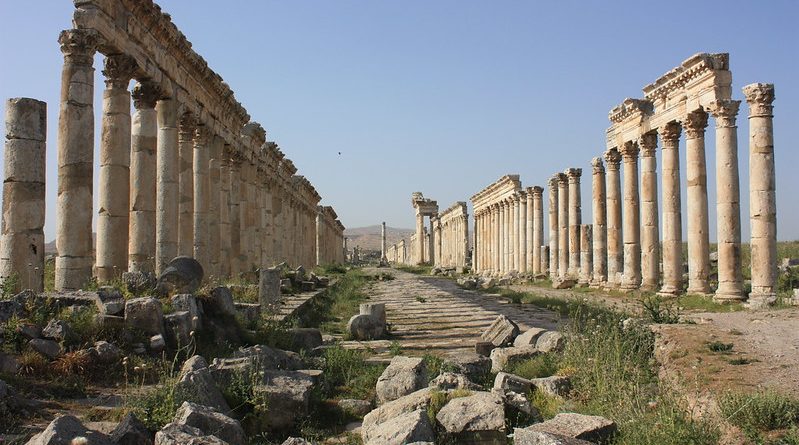The Ancient City of Apamea
On the bank of Syria’s Orontes River lie the remains of ancient city, Apamea. In 300 BC, the city was founded by Seleucus Nicator who served as a General under Alexander the Great. Before Apamea made its way as a major Hellenistic city and epicenter of the Seleucid Empire, it was known as Pharmake. Seleucus’s wife, Apame, was the inspiration for the new title.
Apamea served as the home to a population of an impressive half a million people. Among the half a million were many notable physicians, philosophers, academics and bishops of the time. In addition to its residents, Apamea was also known to host distinguished visitors such as Cleopatra and numerous Roman emperors.
In 64 BC, Roman leader, Pompey, annexed the city into the Roman Empire. This influence is overtly evident in the vast remains of white columns which have served as a major tourist attraction. Even more columns can be seen comprising Apamea’s Great Colonnade, also referred to as the Cardo Maximus. The Great Colonnade at Apamea runs for nearly 2 kilometers. The building of the Great Colonnade took place during the reconstruction period after the overwhelmingly destructive Antioch earthquake hit in 115 AD, making it a forefront for not only great architecture but great Apamean resilience as well.
The ancient city had the Roman Theatre at Apamea to be proud of in addition to the Great Colonnade. The theatre is massive with the credentials of an outstandingly large 139 meter seating section. It is estimated to have held audiences of over 20,000 people and there is only one other larger known theatre (Theatre of Pompey). The theatre went through recent excavation in 2007 under the direction of a united Syrian and American team of archaeologists.
But before you book your trip, understand that Apamea and Syria as a whole are undergoing tumultuous and threatening uprisings in light of the Syrian Civil War. The UK Government website states that the, “The Foreign and Commonwealth Office advise against all travel to Syria” citing terrorism, bombings, and kidnapping as major threats to civilians.
The great ancient city of Apamea itself has fallen victim to looting. Its once refreshing rural setting has suffered devastating damage which mainly includes extensive holes from illegal digging. The severe damage is apparent in satellite images taken barely years apart from each other.
So while the great ancient city of Apamea still remains in part, Syrian leaders, archaeologists, and the greater population are riding on a sliver of hope that it will outlive Syria’s current conflict and exercise the resilience it has through past earthquakes and centuries of aging.
Further Reading:
Globe Trekker Guide to Syria, Jordan and Aleppo
Syrian Looters in Bulldozers Seek Treasure Amid Chaos. Bloomberg.
Uncovering the Great Theater of Apamea. Popular Archaeology.
UK Government. Foreign Travel Advice: Syria
Sacred Destinations. Apamea, Qalaat al-Mudik
By Morgan Lamb




